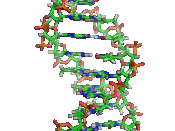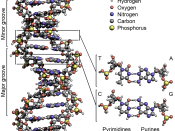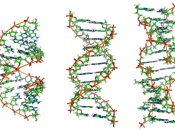�PAGE � �PAGE �1� The Structure of DNA
The Structure of DNA
DNA, or deoxyribonucleic acid, is the hereditary material in humans and almost
all other organisms. Nearly every cell in a person's body has the same DNA. Most DNA
is located in the cell nucleus (it is called nuclear DNA), but a small amount of DNA
can also be found in the mitochondria (U.S. National Library of Medicine, 2009). A
DNA molecule consists of two chains of nucleotides (polymers of nucleic acid each
composed of a phosphate, a five carbon sugar, and a nitrogenous base) that spiral to form
the double helix shape. The nucleotides that forms the DNA structure are organized so
their sugar-phosphate components face the outside and form the backbone of the
structure, whereas the nitrogenous bases face inward. These bases are not all the same,
there are four types in DNA: Adenine, Thymine, Guanine and Cytosine.
When the two
chains of DNA come together to form a helix the bases of one strand bond with the bases
of the other with Adenines only bonding with Thymines and Guanine only binding with
Cytosines. DNA molecules are basically long strands of nucleotides. Groups of
nucleotides are called genes. Therefore, each DNA molecule consists of hundreds or
thousands of genes, each occupying a different section of the strand and genes are
grouped into chromosomes (Miko, 2008). Humans have 46 chromosomes, or other
words 23 pairs of chromosomes.
By the 1940s scientists knew that chromosomes carry the hereditary material.
They knew that chromosomes contained nucleic acids DNA (deoxyribonucleic acid) and
protein. They knew that proteins were complex macromolecules that were very variable
and functionally specific whereas DNA appeared to be a much simpler molecule about
which little was known, but people figured it wasn't variable enough to be...


